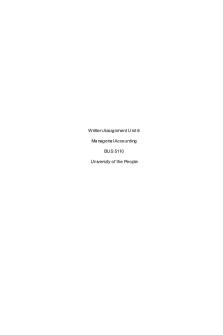4c - written assignment (BUS5110, AY2021-T1) PDF

| Title | 4c - written assignment (BUS5110, AY2021-T1) |
|---|---|
| Author | Rasha Nasser |
| Course | Financial Management |
| Institution | University of the People |
| Pages | 4 |
| File Size | 166.7 KB |
| File Type | |
| Total Downloads | 55 |
| Total Views | 163 |
Summary
vds ...
Description
Vacuum Engine Production BUS 5110 (Managerial Accounting) AY2021-T1 Dr. Peggy January 28 September, 2020
Vacuum Engine Production
1
Vacuum Engine Production For the case study of the vacuum manufacturer engine components, we will take a look at two different scenarios: one where the manufacturer produces the engine component in-house; and the other where the production of the engine component is outsourced. Finally, we will evaluate the efficacy of continuing to produce said engine components in-house or outsource the production and make a recommendation. First, we need to evaluate the cost of production in-house. To do so requires several input values, among them Direct Materials, Direct Labor, Variable Fixed Overhead costs, and Fixed Factory Overhead costs. Direct Materials and Labor numbers are both provided at $75,000 and $100,000 respectively, allowing us to come up with a total of $175,000 per month or $2,100,000 per year. To figure the cost per unit, with unit production being given at 50,000 units per year, we take the total annual cost and divide by 50,000, which gives us a total production cost per unit of $42.00. Next, to get production cost, we add in Variable Fixed Overhead costs (given at $7.50 per unit) and Fixed Factory Overhead costs (given as 150% of Direct Labor cost of $24 per unit - or $36 per unit). This gives us a total cost per unit to produce in-house of $85.50. These past 2 paragraphs are borne-out in the table below:
Vacuum Engine Production
2
Next, we take a look at the cost you outsource the vacuum engine production. Outsourcing the production of the engine component eliminates Direct Materials and Direct Labor costs. We are given the cost per outsourced unit of $60. Additionally, we are given the fact that certain Fixed Overhead costs will remain, with the amount being the equivalent of 75% of the previous Fixed Factory Overhead ($36 per unit), giving us a Fixed Overhead number of $27.00 per unit. These costs include executive salaries, rent, depreciation, and taxes. Adding the outsourced unit cost to the fixed overhead cost gives us an outsourced cost of $87 per unit. This information is borne-out in the table below:
Finally, we perform a cost-benefit analysis of producing the engine component in-house versus outsourcing the production. In the problem, sales price per unit ($150) is given; however, the information given is irrelevant to production costs. Given an outsourced production cost of $87 per unit and an in-house production cost of $85.50, the initial recommendation would be to continue building the engine component in-house and not outsource production. We do not have certain information - for instance: what executives are being paid how much, what the facility is and how much of it is devoted to the production of the engine component and what bearing this has on rent. Were the company you outsource the production of the engine component, it is possible there would be a significant drop in the space needed for
Vacuum Engine Production
the production floor and a cost-benefit analysis should be made of whether or not to continue renting existing facilities or to move to a smaller facility with lower rent. While the recommendation from this case study is that the vacuum company continue to manufacture their own engine components and not outsource them, it is strongly recommended that said company evaluate the components of the Fixed Overhead costs to look for cost savings that could change the recommendation given.
3...
Similar Free PDFs

Written assignment
- 4 Pages

Written Assignment
- 4 Pages

Written Assignment
- 2 Pages

Written Assignment Unit 2
- 3 Pages

Written Assignment Unit 7
- 3 Pages

Written Assignment UNIT 5
- 6 Pages

Written Assignment Unit 2
- 5 Pages

UNIV1001 written assignment 5
- 3 Pages

SOC1502 - Written Assignment 2
- 4 Pages

Written Assignment Unit 2
- 1 Pages

Written Assignment 4
- 4 Pages
Popular Institutions
- Tinajero National High School - Annex
- Politeknik Caltex Riau
- Yokohama City University
- SGT University
- University of Al-Qadisiyah
- Divine Word College of Vigan
- Techniek College Rotterdam
- Universidade de Santiago
- Universiti Teknologi MARA Cawangan Johor Kampus Pasir Gudang
- Poltekkes Kemenkes Yogyakarta
- Baguio City National High School
- Colegio san marcos
- preparatoria uno
- Centro de Bachillerato Tecnológico Industrial y de Servicios No. 107
- Dalian Maritime University
- Quang Trung Secondary School
- Colegio Tecnológico en Informática
- Corporación Regional de Educación Superior
- Grupo CEDVA
- Dar Al Uloom University
- Centro de Estudios Preuniversitarios de la Universidad Nacional de Ingeniería
- 上智大学
- Aakash International School, Nuna Majara
- San Felipe Neri Catholic School
- Kang Chiao International School - New Taipei City
- Misamis Occidental National High School
- Institución Educativa Escuela Normal Juan Ladrilleros
- Kolehiyo ng Pantukan
- Batanes State College
- Instituto Continental
- Sekolah Menengah Kejuruan Kesehatan Kaltara (Tarakan)
- Colegio de La Inmaculada Concepcion - Cebu




